Rent hikes and evictions â is it the last stand for artists in the Arts District?
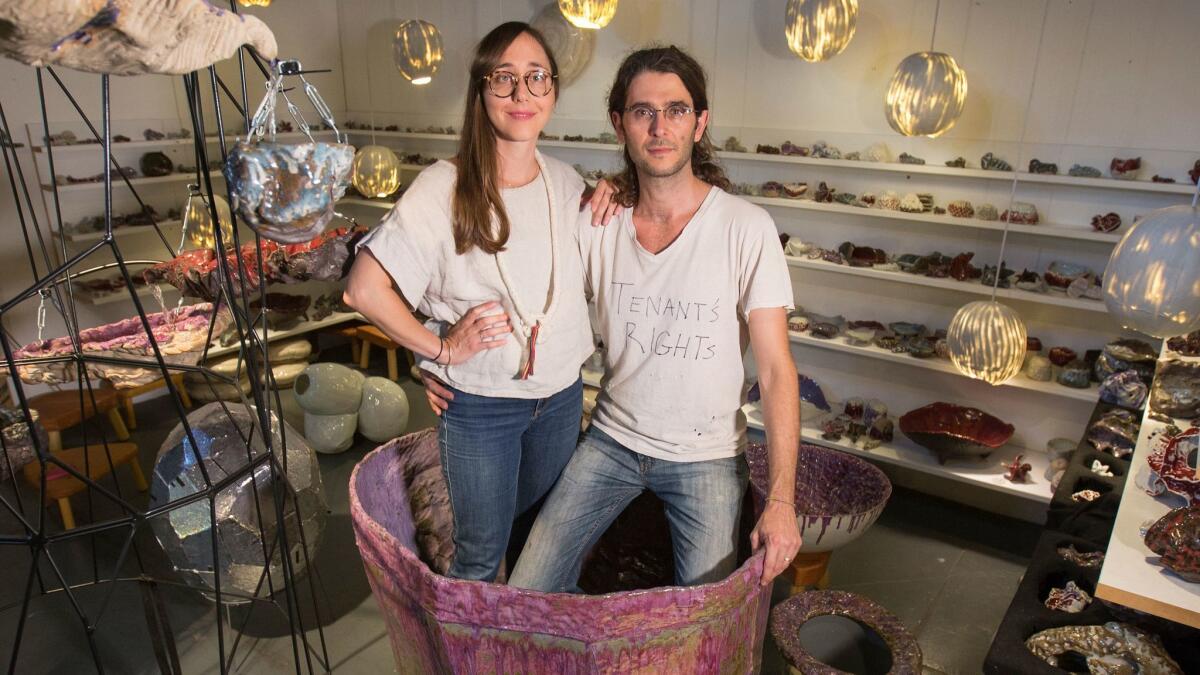
The knock came on the door just as Michael Parker was talking with a group of German urbanism students about the challenges facing artists in Los Angeles. It was a warm September afternoon and they were in Parkerâs Arts District loft, a rambling, sculpture-filled space he shares with four fellow artists, including his wife, conceptual artist Alyse Emdur.
A student stood up to answer the door.
ââThere are two men with an envelope and they said they need to see you,ââ Parker recalls the student saying. âI was like, âOmigod, I am meeting with this group of urban planners and Iâm being served eviction papers.ââ
Indeed, inside a plain manila envelope was an eviction summons.
âIt felt really surreal,â Parker says with a sardonic laugh. âI have all of these urban theorists from abroad asking how Los Angeles works â and this happens.â
Parker isnât the only artist who faces a tenuous future in the Arts District. Named for the artists who made the neighborhood a creative hub in the 1970s and â80s, the Arts District could soon find itself with few actual artists living within its borders â no small irony given its name and the fact that Mayor Eric Garcetti likes to regularly tout Los Angeles as an âarts capitalâ in statements and speeches.
At 800 Traction Ave., a warehouse building that began life as a coffee and spice factory in 1918, residents have received a 60-day quit notice. Just beyond the southern fringes of the Arts District, the Santa Fe Art Colony is expected to start charging market rates after operating for 30 years under a contract with the now-defunct Community Redevelopment Agency as a low- and moderate-income housing site; that contract is now expiring.
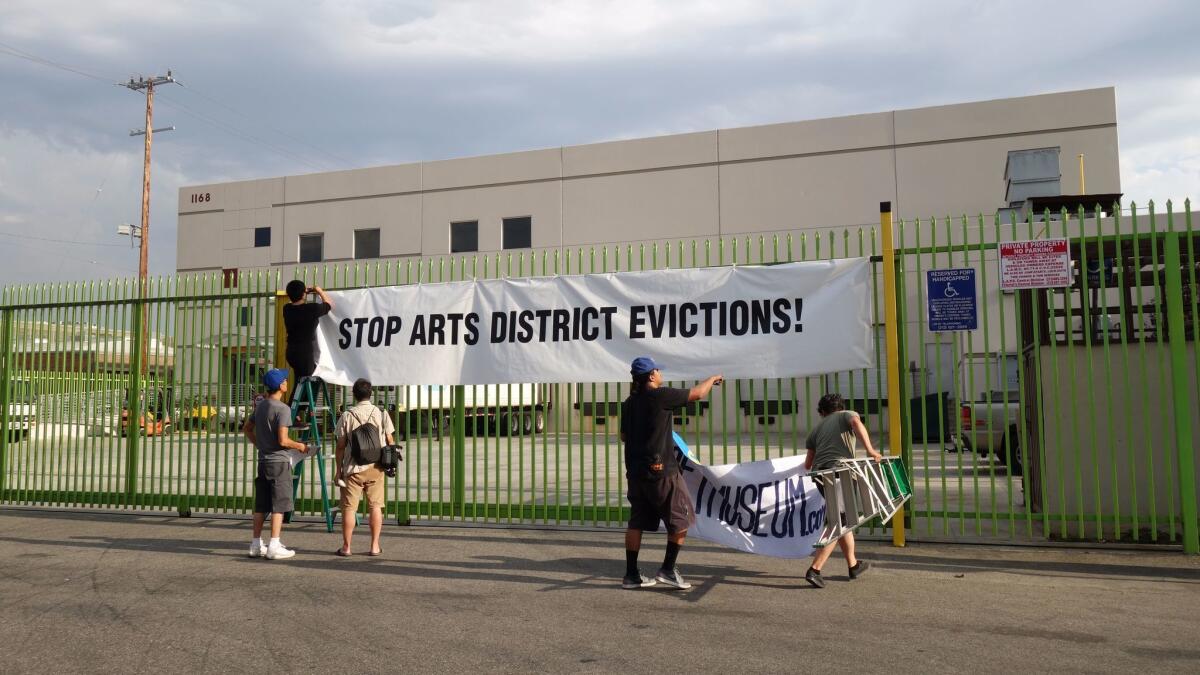
An Arts District devoid of artists âwould be a horrible irony and a cruel travesty for that community and for the City of Los Angeles.â
— Jose Huizar, Los Angeles city councilman
This follows the departure of many other Arts District artists, including Michael Winter, who ran the avant-garde musical space the Wulf out of his loft on Santa Fe Avenue until last fall when new owners bought his building.
Art Share L.A., at the corner of Hewitt Street and East 4th Place, is one of the neighborhoodâs last artist-focused buildings. A nonprofit that supplies low-income housing, Art Share, with public spaces that include a theater and a gallery, isnât specifically designated for artists, but thatâs who it generally attracts. Itâs also one of the few artist spaces with a sense of permanence: the organization owns its building and the site is restricted, by deed, to supply low-income housing for at least half a century.
Altogether, however, artists are an endangered species in the neighborhood they are most closely identified with.
City Councilman Jose Huizar, who represents the neighborhood, says an Arts District devoid of artists âwould be a horrible irony and a cruel travesty for that community and for the City of Los Angeles.â
Parker, who is fighting his eviction with the assistance of attorney Elena Popp of the Eviction Defense Network, says itâs a critical moment.
âIt feels,â he says, âlike a last stand.â
Not all art is created equal
In recent years, the conversation about art and gentrification has principally centered on the role that art and arts institutions can play in the transformation of neighborhoods. And in that narrative, art and community are often portrayed as being on opposite sides of the battlefield.
In Los Angeles, the most visible front line sits right across the river from the Arts District in Boyle Heights, where anti-gentrification protesters have criticized artists and galleries for âart washingâ â that is, being complicit in displacement.
But that headline-ready storyline simplifies a more complicated reality, as the changes in the Arts District lay bare. For one, urban planning studies show that the presence of galleries doesnât so much cause gentrification as mirror the larger forces that shape it â urban policy, development, settlement patterns, the economy.
And not all art is created equal. The presence of a big international gallery with access to capital â such as the 116,000-square-foot Hauser & Wirth â is different than that of individual artists, many of whom cobble a living out of poorly paid adjunct teaching positions. Plus, artists are frequently gentrified themselves, sometimes by developers who like to tout the power of art in their projects.
More significantly, the case of the Arts District raises the question of whether Los Angeles will continue to be a city hospitable to the ad-hoc artist communities from which bubble up groundbreaking ideas that shift currents and shape movements. Think of those paradigm-shifting California light-and-space artists clustered in Venice Beach in the 1960s.
Sylvia Tidwell, who has lived at the Santa Fe Art Colony for almost 20 years and is head of its tenants association, says an Arts District without artists would be âbleakâ â âan empty shell.â
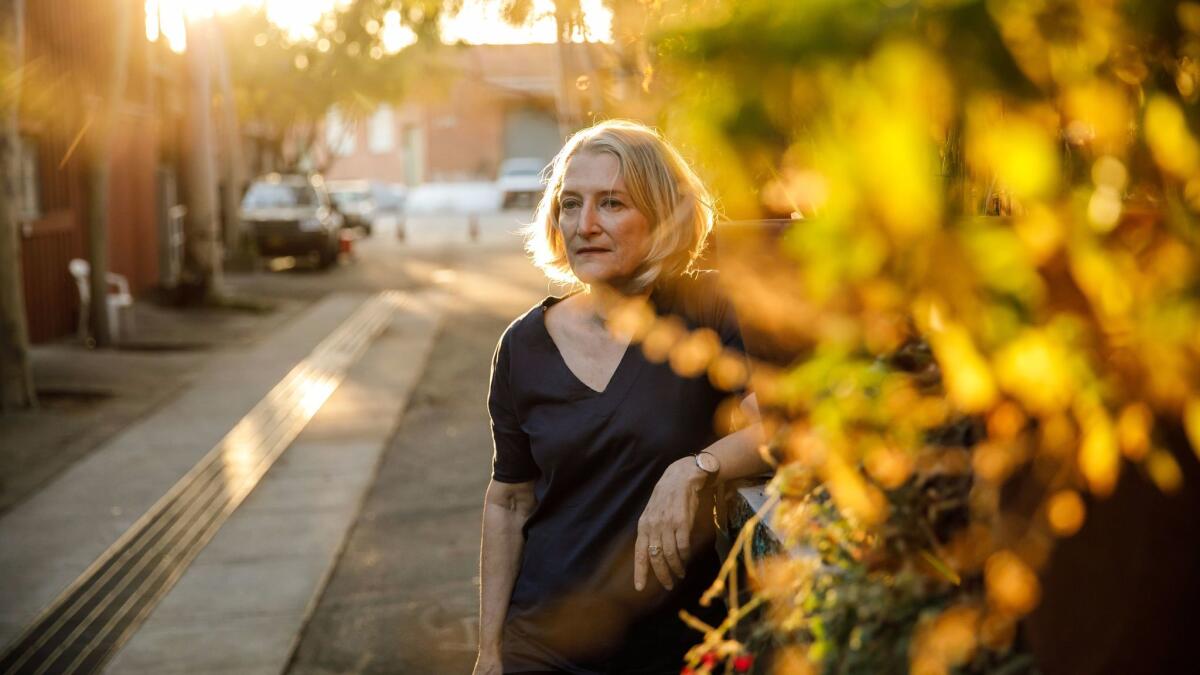
The Santa Fe Art Colony, with its 57 artist lofts spread over roughly two acres, allows for an ongoing dialogue between a community of artists.
âIf at one in the morning, you need cadmium red, you can find it,â she says. âThere is a lot of shared energy and a lot of shared purpose. Itâs a nexus. You always have that where the arts flourish. You always have that when you have artists going to each otherâs studios.â
Parker concurs.
In 2001, he and two fellow artists took over the roughly 5,000-square-foot-loft on Seaton Street. It didnât have heat or air conditioning. But it was cheap â a grand total of $2,250 per month â and it allowed Parker and his friends plenty of space in which to live and work. (Last year, he had a major installation on view in San Pedro as part of the public art biennial âCurrent: LA Water.â)
But it also served as an important point of exchange. Over the last 16 years, more than three dozen artists have spent time in the space, including installation artist Joel Kyack and conceptualist Lisa Anne Auerbach.
âI was 22 when I moved in,â Parker says. âOur neighbor was a 60-year-old artist, George Stone, this conceptual performance and video artist. I could walk up and down the stairs with him and talk things out. I had this older man that was there who was an artist who had this wealth of knowledge and experience.â
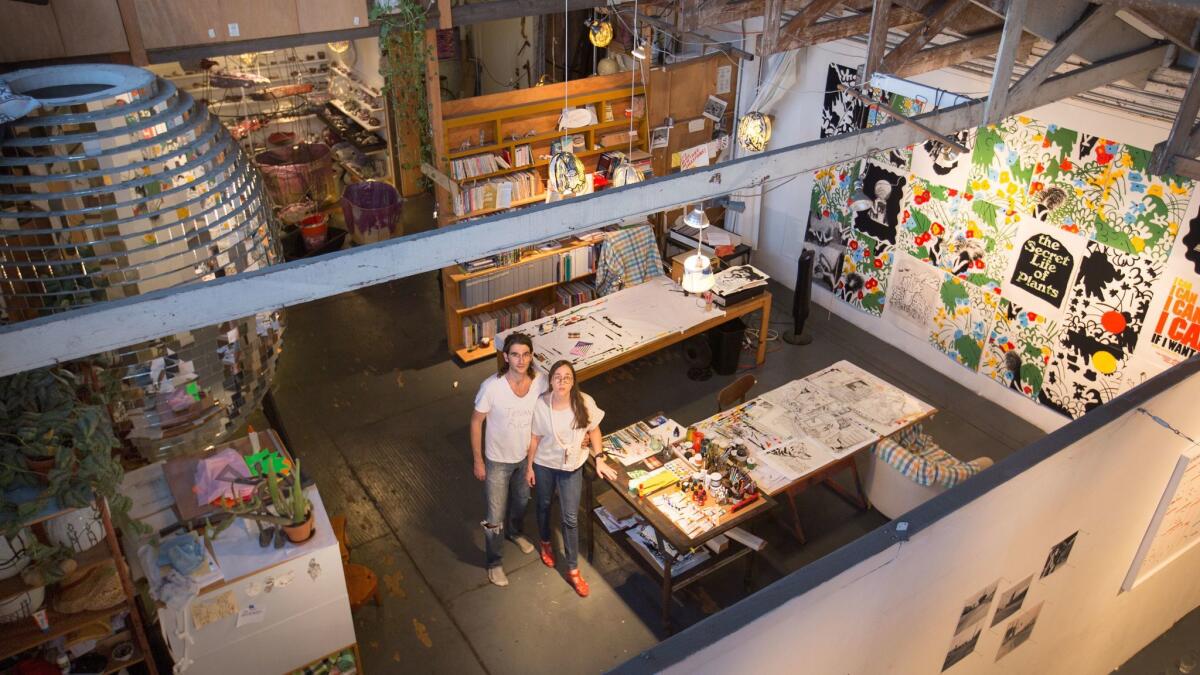
In July, when he received a notice from his landlord that the loftâs rent would rise from $4,750 a month to $6,800, and that he and his roommates would no longer be able to inhabit the space, he was frustrated not only about the prospect of losing his home but losing an important artistic hub. As a response to the rent hike, he organized an impromptu show in his loft that pays tribute to the many artists who had passed through the space, an exhibition dubbed the âArtistsâ Loft Museum Los Angeles.â
For Winter, who helped found the Wulf, having a physical space was key to the cultivation of a musical avant-garde â where performers could do things like play homemade instruments and present difficult pieces.
âWe didnât need to plan in advance and that was a benefit to everybody,â he says. âSomeone would be like, âI wrote a new piece,â and we could put it on within a week. It was run by artists for artists as an outlet to really test stuff, to be a laboratory for exploration.â
Winter says he searched high and low for a new space in L.A. after losing his loft, but couldnât find anything that fit his budget and would accommodate small concerts by the likes of composers Wadada Leo Smith and Wolfgang von Schweinitz. Late last year, he relocated to Mexico City and left the Wulf in the hands of an artist advisory board that occasionally stages performances in a borrowed storefront belonging to the Coaxial Arts Foundation. Next year, Winter is headed to a residency in Germany.
âIdeally I would love to come back to L.A.,â he says, âbut itâs not in the cards.â
As artists disperse, at stake are the intellectually fertile pockets that feed the creation of art in Los Angeles.
Painter Nancy Uyemura moved to 800 Traction in the 1980s, when the Arts District offered little in the way of amenities. There, she shared a warehouse loft with the late abstract expressionist painter Matsumi Kanemitsu, whose archive she now manages.
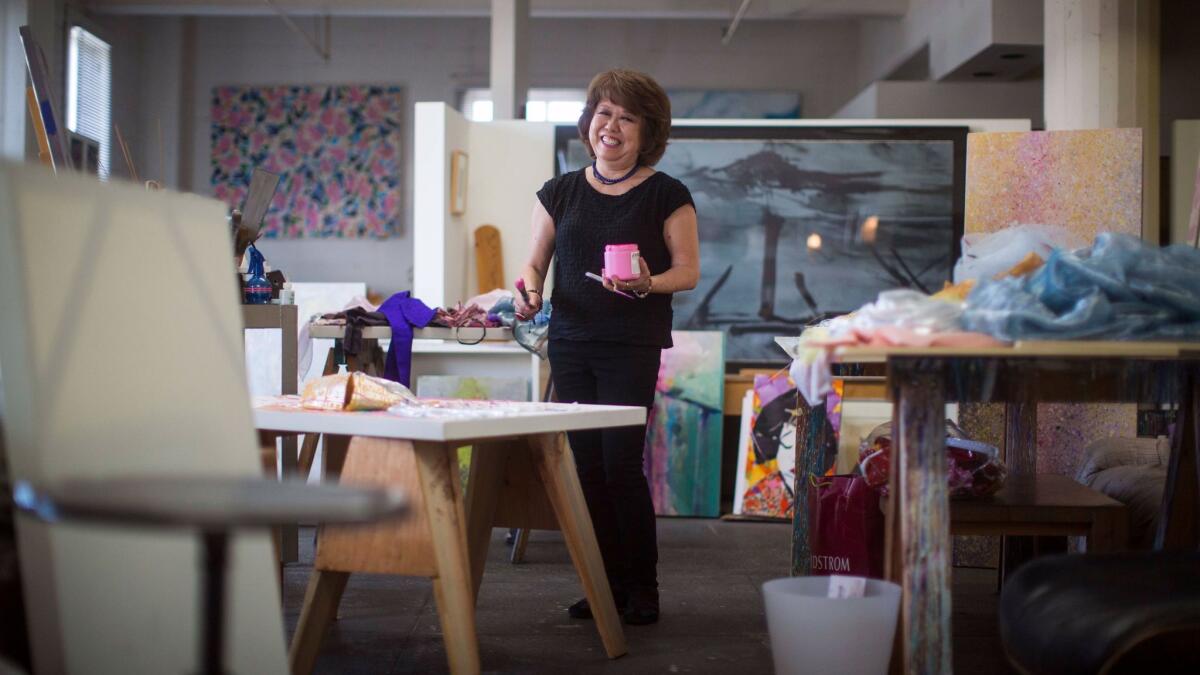
Over more than three decades, she and the other artists in the building â most of them Japanese American, most of them in their 60s â have formed a familiar bond.
âIf we have to move out to Riverside or the Valley or whatever, itâs too hard to come back,â she says. âWe would lose our community.â
Thin margins
Part of the narrative of art in todayâs gentrification battles is art as a symbol of all that is blue chip. Six-figure paintings. Pristine white-box galleries. Industry insiders who sip Champagne and jet-set from art fair to biennial to career retrospective. Certainly, that exists (as a gander at Artforumâs âScene & Herdâ column will attest). But it is only at the rarefied levels.
In 2014, an analysis of census data by the group BFAMFAPhD, a collective of artists, organizers and others, showed that only 10% of art school graduates were making a living as artists. More than 6% toiled in service jobs. Another roughly 17% worked primarily as educators.
Many artists operate on thin margins â which can make something like a rent increase devastating.
At the Santa Fe Art Colony, for example, where CRA-mandated rent restrictions are in the process of expiring, artists are facing steep hikes of up to 100%.
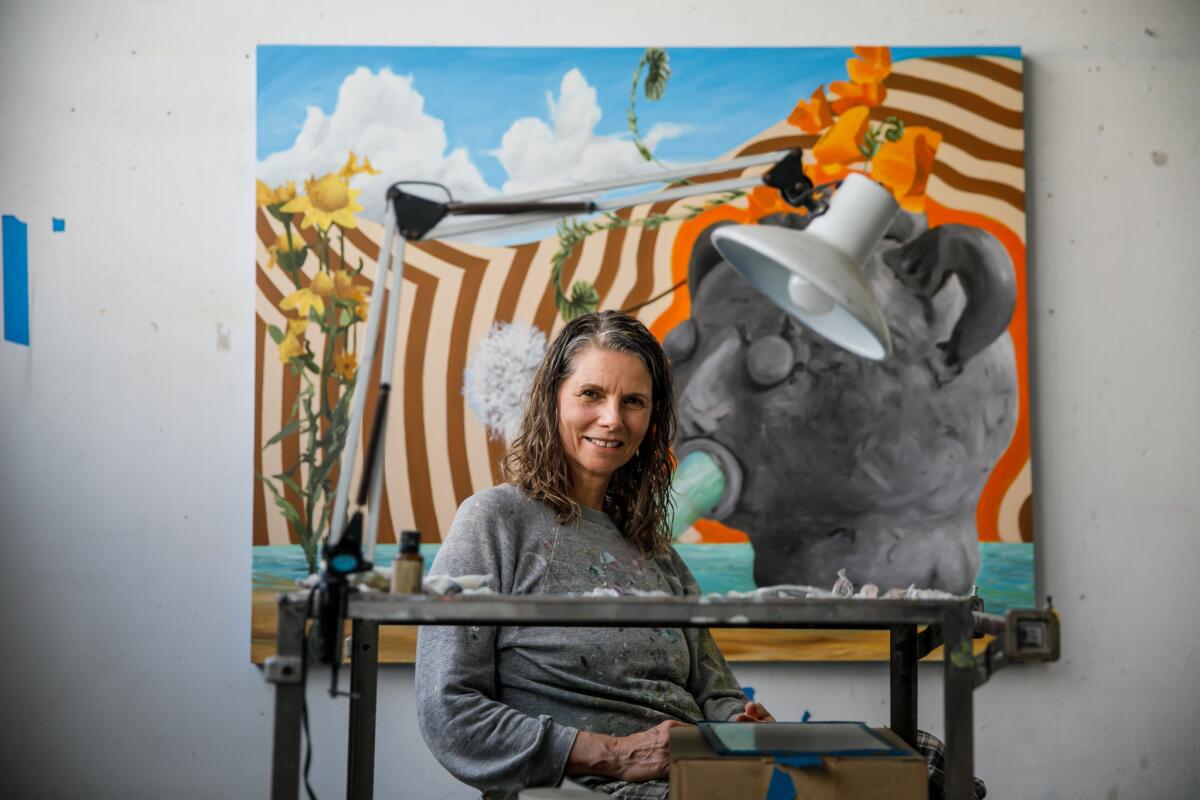
âSome are 50%, some are 30%,â says Tidwell, who in her role with the Santa Fe Art Colony Tenants Assn. has taken time away from her painting to pore over the state laws that govern CRAs. âSome people are paying $981 a month. Those people are now going to be paying $1,450 or $1,550.â
It may not sound like a lot in a part of Los Angeles where a two-bedroom, 1,000- square-foot-loft can go for upwards of $4,500 a month. But as Tidwell says, âthese are substantial increases for artists.â
Tidwell and other members of the colonyâs tenants association have been exploring making an offer on the property (allowed under the terms of the CRA contract) to keep the space affordable and artist-focused. But she says she hasnât been able to gather the necessary paperwork from the buildingâs owners, Leonard Skuro and Marvin Zeidler (the former a sculptor; the latter an arts patron who has supported the Skirball Cultural Center).
After requesting the buildingâs financials â and after a deputy city attorney told a lawyer for the owners to provide âinformation necessary to make an informed offerâ â Tidwell was sent a rent roll and handwritten sheet that is presumably the buildingâs expenses.
âWhat is this?â Tidwell says, pointing to one of the scrawled line items. âThey wonât answer.â
A lawyer for Zeidler said only that his clients have no intention of selling the building.
Part of the problem for many artists is zoning. Many artists inhabit industrial spaces zoned for manufacturing and are bound by commercial not residential leases.
âIn other neighborhoods I represent, like Boyle Heights, 75% of the residents are renters, and nearly 90% of those live in rent-controlled units, which have inherent protections,â Huizar notes via email. âIn the Arts District thatâs not the case.â
The artists at 800 Traction, for example, have commercial leases, as does Parker.
When Parker received the notice of rent increase from his landlord, he says he asked for another offer. âMy response was that this was unaffordable and I want to live here,â he says.
Hedy Ghavidel, a lawyer at the firm of Harold Greenberg, which represents Capital KCS, the buildingâs owner, states, âHis rent was going up to what the law allows.â She notes that the building remains âextremely affordableâ given the fact that real estate in the neighborhood can go for $305 a square foot. (Representatives for DLJ Real Estate, which owns 800 Traction, did not return calls for comment.)
Even as artists get pushed out, however, art is nonetheless used as a selling point. Some developments have artist-in-residence programs, which provide free living space to artists for a short period of time. Others use art as a lure for marketing purposes.
Capital KCS is attempting to develop a mixed-use complex on the site of the Seaton Street warehouse that features live-work condos and an art hotel. âTo keep things artsy,â reads the website, âthe complex will also include a pedestrian-oriented âart plaza.ââ The proposed development is currently titled the âArts District Centerâ and the renderings show a glassy box rising from the shell of the old warehouse building. The website features I.M. Peiâs glass pyramid at the Louvre and the Apple Store in New York as design inspirations.
Developers may tout murals, sculpture parks and artist residencies as evidence of artsiness, but these often feature art that is blandly attractive â and not the sort of work that challenges the status quo. Emdur, who lives at the Seaton Street loft, for example, recently completed a multi-year project in which she examined the nature of prison murals. Itâs difficult to imagine a developer offering her free rent for her work.
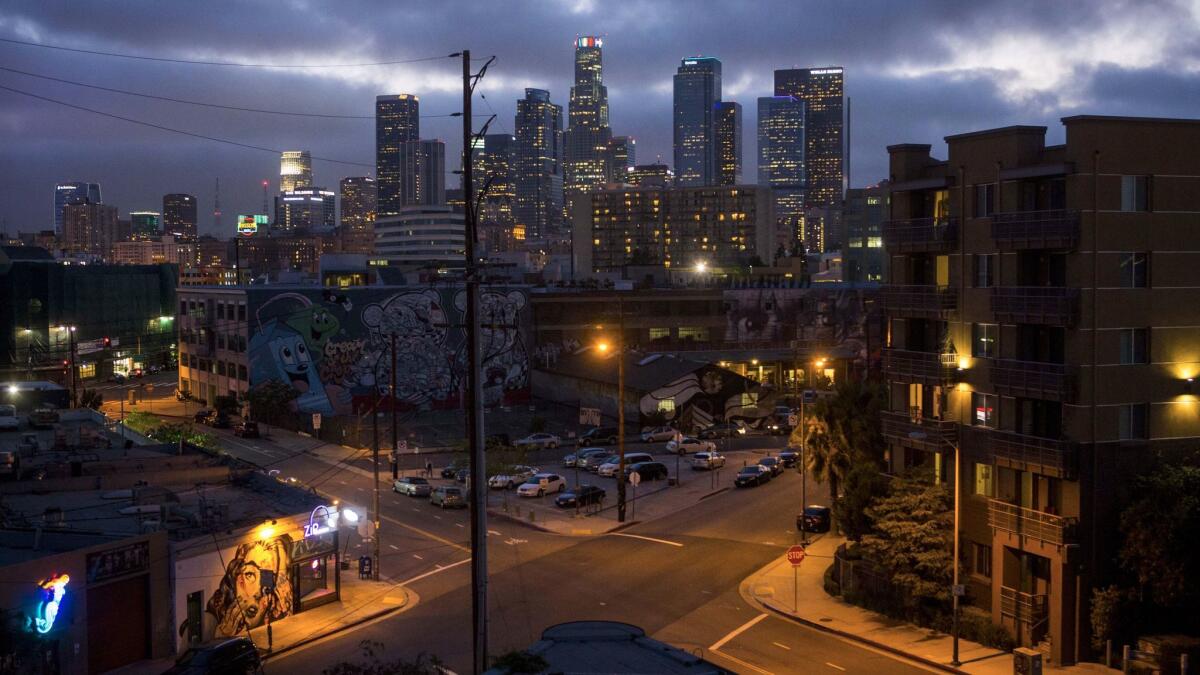
Now the big question is: Where will the artists of the Arts District go?
âI donât want to go gentrify other neighborhoods that are being gentrified,â Parker says. âBut I am now being gentrified and I donât know where to go.â
Even neighboring Boyle Heights is already pricey. A two-bedroom bungalow can go for upwards of $3,000 a month.
âToday, we have an affordable housing crisis throughout the city, county and state,â says Huizar. âDisplacement is a real issue in Los Angeles for people from all backgrounds and in communities throughout the city.â
Parker says he is focused on fighting the eviction â but for the first time in his career, he says he is also looking outside L.A.
âIâm applying for jobs and residencies in other places,â he says. âWhatâs next is really unsure. Maybe itâs taking a break from Los Angeles.â
For L.A., an irrevocable loss.
Sign up for our weekly Essential Arts & Culture newsletter Âť
ALSO
âGet out!â said the cops: Art pioneers of downtown L.A. share memories of building a scene
Now that artists canât afford the Arts District, L.A. needs to rethink its role as a creative city
Boyle Heights activists say white art elites are ruining the neighborhood...but itâs complicated
After you visit Hauser & Wirth: our handy art map to 15 more downtown L.A.-area galleries
More to Read
The biggest entertainment stories
Get our big stories about Hollywood, film, television, music, arts, culture and more right in your inbox as soon as they publish.
You may occasionally receive promotional content from the Los Angeles Times.











